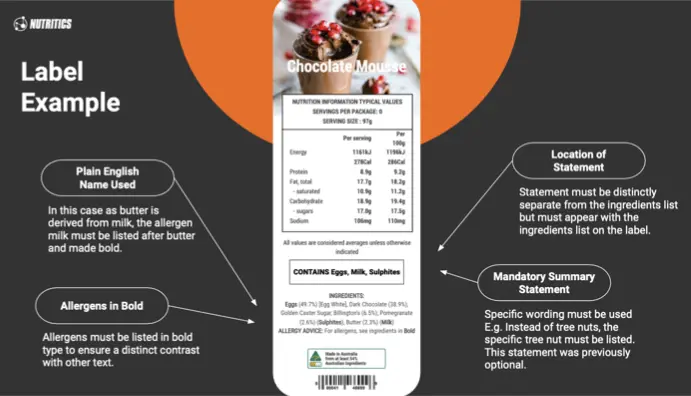In February 2021, Food Standards Australia New Zealand (FSANZ) amended the requirements for the labelling of allergens in food. This is known as the Plain English Allergen Labelling (PEAL). Businesses must comply with these requirements by February 2024. Until then, during this period of transition, food businesses may comply with either the existing allergen declaration requirements in the Australia New Zealand Food Standards Code (‘the Code’), or the new requirements.
Background
Certain foods and ingredients can cause severe allergic and other adverse reactions in some people. The Code requires these to be declared on labels when they are present in food.
In 2017, FSANZ began to consider introducing some changes to the Code to ensure that mandatory food allergen declarations would become clearer, more consistent and presented in plain English.
On 25 February 2021, the Code was officially amended in order to introduce new requirements for the labelling of allergens in food.
What’s new?
The amended requirements include the specifications that allergen information is to be declared:
- in a specific format and location on food labels,
- using simple, plain English terms, and
- in a bold font.
They also require the following:
- Specific terminology: Common English names must be used; for example, a label must now use the word ‘soy’ rather than ‘soya’ and/or ‘soya bean. Processing aid (allergen) required’.
- Expansion of allergens: Fish, crustacea and molluscs must be listed separately. The names of specific tree nuts and cereals are to be listed.
- Mandatory summary statement: Allergens MUST be included in the ingredients list and must also be supplemented with a mandatory summary statement beginning with the word ‘contains’, in the same field of view as ingredients, but distinctly separated from the ingredients list and in bold type.
- Specific format: There are new specifications around font size, type and bold type, designed to ensure a distinct contrast with other text. This font must be used for only the standardised allergen phrase and contain no other words.
See the illustration below for an example of how allergens on food labels must now be presented.

What does this mean for your business?
- Improved customer experience. PEAL-compliant labelling will provide greater transparency to customers. Studies show that shopping takes significantly longer for those who suffer from nut allergies. Affected people are likely to adopt a “better safe than sorry” mentality and avoid products and establishments with unclear food labelling, so this will make your business more attractive.
- Increased profits. People with allergies are willing to pay more for products that have clearly labelled allergens. Many are willing to pay more in food costs for the peace of mind provided by the inclusion of clear allergen labelling.
- Customer safety. Improving allergen compliance reduces the likelihood of a critical incident. Complying with the PEAL requirements will help to safeguard your customers — and your business — against allergic reactions that may be life-threatening.
- The cost of label updates. The downside is that finding a solution has the potential to be very costly. FSANZ estimates that the cost to the food industry will be between $2,000 and $4,000 per product line/SKU. This is where Nutritics can help, significantly reducing the costs incurred.
Let us do the hard work for you.
Using a software solution like Nutritics removes the risk of human error by automating the ingredient inputting process. Our software now enables your business to print labels to the standards required by PEAL. If there is any information missing, our software will alert you to this.
Nutritics software also captures any supplier changes and flags them automatically. If there has been a change in an ingredient, you will be alerted immediately. The system will automatically note any allergens and feed the changes all the way from your recipe management process through to label generation and printing.
The Nutritics LabelMagic system enables you to share verified food label information from production sites to different locations in real time and in a read-only format. Printing on site is facilitated by a separate tablet and Bluetooth-connected printer, minimising the risk of incorrect label information being displayed with a completely automated process, controlled at the point of production.
Book a free demo today to learn more about how Nutritics can take the stress out of allergen management.
